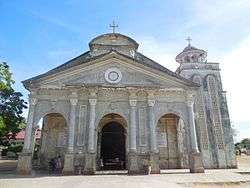Panglao, Bohol
| Panglao | |
|---|---|
| Municipality | |
|
The San Agustin Parish Church in Panglao | |
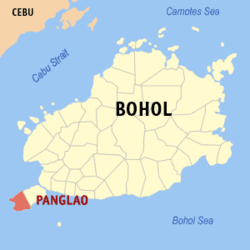 Map of Bohol with Panglao highlighted | |
.svg.png) Panglao Location within the Philippines | |
| Coordinates: 9°35′N 123°45′E / 9.58°N 123.75°ECoordinates: 9°35′N 123°45′E / 9.58°N 123.75°E | |
| Country | Philippines |
| Region | Central Visayas (Region VII) |
| Province | Bohol |
| District | 1st district of Bohol |
| Founded | 1803 |
| Barangay | 10 (see § Barangays) |
| Government [1] | |
| • Type | Sangguniang Bayan |
| • Mayor | Leonila Montero (PDP) |
| • Vice mayor | Pedro Fuertes |
| • Town Council |
Members
|
| • Representative | Rene Relampagos |
| Area[2] | |
| • Total | 51.2 km2 (19.8 sq mi) |
| incl. Balicasag island and others | |
| Population (2015 census)[3] | |
| • Total | 33,553 |
| • Density | 660/km2 (1,700/sq mi) |
| • Voter (2016)[4] | 21,394 |
| Time zone | PST (UTC+8) |
| ZIP code | 6340 |
| IDD : area code | +63 (0)38 |
| Income class | 4th class |
| PSGC | 071233000 |
| Website |
www |
Panglao is a 4th municipal income class municipality in the province of Bohol, Philippines.[2] According to the 2015 census, it has a population of 33,553, 18 kilometres (11 mi) from Tagbilaran.[3] In the 2016 election, it had 21,394 registered voters.[4]
It is one of two municipalities that make up Panglao Island (the other being Dauis), and its territory also includes the three smaller islands of Balicasag,[5] Gak‑ang, and Pontod (or Pungtud, also known as Virgin Island).[6] Panglao is known for its diving locations and tourist resorts.
The name Panglao may have come from its former name Panglawod, meaning "to the open sea",[7] or derived from the word panggaw, referring to a fishing implement used by locals.[6]
Panglao has educational institutions, including the San Agustin Academy (Panglao), Lourdes National High School, the Cristal e-College, and elementary schools located in every barangay (including the Panglao Central Elementary School).
There are no fresh water streams or lakes on the island, so for its drinking water, the municipality is dependent on wells and the Canhilbas Underground Spring.[6]
History
Well before the Spanish colonization, the area was already long visited by Chinese and other Asian traders, as evinced by archaeological finds of Tang, Song, and Ming dynasty porcelain and trade wares.[6]
Panglao flourished during the rule of the Dapitan kingdom, but raids by Moluccans and conquest by Ternate resulted in periods of depopulation when its population fled mostly to Panay and Mindanao, including Dapitan.[6]
During the Spanish rule, a Jesuit mission post was established, that in 1782 was formed into a parish, known as La Iglesia de San Agustin de Panglawod. In 1803, the town was officially made into a municipality.[7]
The Panglao watchtower was built in 1851. The 5-storey octagonal tower is the tallest of its kind in the Philippines but suffers from neglect.[7]
Geography
Climate
| Climate data for Panglao, Bohol | |||||||||||||||
|---|---|---|---|---|---|---|---|---|---|---|---|---|---|---|---|
| Jan | Feb | Mar | Apr | May | Jun | Jul | Aug | Sep | Oct | Nov | Dec | Year | |||
| 30.3 86.5 |
30.5 86.9 |
31.4 88.5 |
32.6 90.7 |
33.1 91.6 |
32.5 90.5 |
32.1 89.8 |
32.3 90.1 |
32.1 89.8 |
31.9 89.4 |
31.6 88.9 |
31.0 87.8 |
31.8 89.2 | |||
| 26.3 79.3 |
26.3 79.3 |
26.9 80.4 |
27.9 82.2 |
28.5 83.3 |
28.1 82.6 |
27.8 82.0 |
27.9 82.2 |
27.7 81.9 |
27.6 81.7 |
27.3 81.1 |
26.9 80.4 |
27.5 81.5 | |||
| 22.3 72.1 |
22.2 72.0 |
22.5 72.5 |
23.3 73.9 |
23.9 75.0 |
23.7 74.7 |
23.5 74.3 |
23.6 74.5 |
23.4 74.1 |
23.3 73.9 |
23.1 73.6 |
22.9 73.2 |
23.1 73.6 | |||
| 119 4.7 |
90 3.5 |
88 3.5 |
70 2.8 |
96 3.8 |
147 5.8 |
137 5.4 |
116 4.6 |
130 5.1 |
190 7.5 |
217 8.5 |
144 5.7 |
1,544 61 | |||
| Climate-data.org[8] July 2016 | Köppen-Geiger climate classification Af | Coronas type III | |||||||||||||
Barangays
Panglao comprises 10 barangays:
|
|||||||||||||||||||||||||||||||||||||||||||||||||||||||||||||||||||||||||||||||||||||||||||||||||||||||||||||||||||||||||||||||||||||||||||||
Demographics
| Population census of Panglao | |||||||||||||||||||||||||
|---|---|---|---|---|---|---|---|---|---|---|---|---|---|---|---|---|---|---|---|---|---|---|---|---|---|
|
| ||||||||||||||||||||||||
| Source: Philippine Statistics Office[3][9][10] | |||||||||||||||||||||||||
In the 2016 election, it had 21,394 registered voters, meaning that 64% of the population are aged 18 and over.[4]
Tourism
The primary tourist attraction of Panglao are its white sandy beaches, of which Alona Beach is the most famous and most developed. Alona Beach is about 1,500 metres (1,640 yd) long, lined with palm trees. resorts, and shops.[11] However it has drawn criticism for its unrestrained development that ignored municipal development policies, warning against overcrowding and Alona to lose its paradise-like image.[12] Therefore, the municipal, provincial and national governments are ploughing ahead with a plan to build a new international airport on Panglao island, with the final approach path directly over Alona beach. Other beaches include Bagobo, Bolod, Danao, Doljo, and Momo Beaches.
Panglao is renowned for snorkeling and dive sites such as Doljo Beach, Garden Eels, Arco Point, Kalipayan, Napaling, and Puntod. The island's southern portion is ringed with reefs that are relatively narrow and shallow (5 to 6 metres (16 to 20 ft)) with submarine cliffs plunging to depths of 33 to 56 metres (108 to 184 ft).[13] Tours can readily be arranged to further dive sites, including Balicasag and Pamilacan islands.
Gallery
 Playing basketball in Panglao, Bohol
Playing basketball in Panglao, Bohol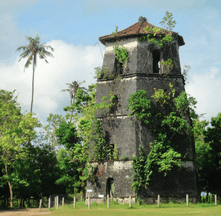 Panglao watchtower
Panglao watchtower.jpg) Panglao Island Nature Resort
Panglao Island Nature Resort Alona Beach, Panglao, Bohol
Alona Beach, Panglao, Bohol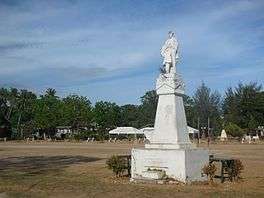 Rizal Monument at Panglao plaza
Rizal Monument at Panglao plaza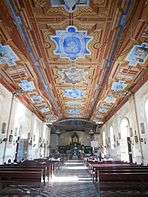 Interior of the San Agustin Parish Church
Interior of the San Agustin Parish Church
References
- ↑ "Municipality". Quezon City, Philippines: Department of the Interior and Local Government. Retrieved 31 May 2013.
- 1 2 3 "Municipal: Panglao, Bohol". PSGC Interactive. Quezon City, Philippines: Philippine Statistics Authority. Retrieved 8 January 2016.
- 1 2 3 4 "Region VII (CENTRAL VISAYAS)". Census of Population (2015): Total Population by Province, City, Municipality and Barangay (Report). PSA. Retrieved 20 June 2016.
- 1 2 3 "2016 National and Local Elections Statistics". Commission on Elections. 2016.
- ↑ "Balicasag Island". Dream Native Resort. Archived from the original on 25 June 2015. Retrieved 14 July 2016.
- 1 2 3 4 5 "Municipal Profile". Municipality of Panglao. Retrieved 5 September 2012.
- 1 2 3 "Bohol Panglao Island Travel Guide". A1 Online Communication and Advertising. Retrieved 6 September 2012.
- ↑ "Climatological Information for Panglao, Bohol". AmbiWeb GmbH. Retrieved 14 July 2016.
- 1 2 "Region VII (CENTRAL VISAYAS)". Census of Population and Housing (2010): Total Population by Province, City, Municipality and Barangay (Report). NSO. Retrieved 29 June 2016.
- ↑ "Region VII (CENTRAL VISAYAS)". Census of Population (1995, 2000 and 2007): Total Population by Province, City and Municipality (Report). NSO. Archived from the original on 24 June 2011.
- ↑ "Alona Beach, Panglao Island". A1 Online Communication and Advertising. Retrieved 6 September 2012.
- ↑ Philstar, Angeline Valencia (15 August 2012). "Mayor Alcala warns Panglao may become as crowded as Boracay". Retrieved 6 September 2012.
- ↑ "Panglao Island Diving". A1 Online Communication and Advertising. Retrieved 6 September 2012.
External links
| Wikimedia Commons has media related to Panglao, Bohol. |
 |
Cebu Strait | Dauis |  | |
| Cebu Strait | |
Bohol Sea | ||
| ||||
| | ||||
| Bohol Sea |
